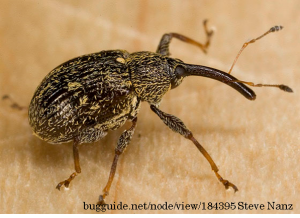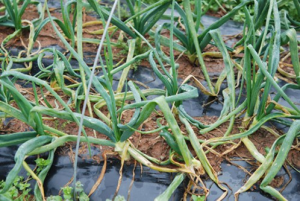As of Friday, April 21, we confirmed that ALM is in south Jersey and it is likely that it can be found throughout the state. Infested field chives were found in East Vineland as well as in backyard chives in Atlantic County and onion sets in the Middlesex/Monmouth County area. Feeding scars have been found in wild garlic which is abundant in New Jersey. So far, adult flies have only been trapped in chives. Given how chives are harvested, it is difficult to assess how damaging the fly will be to the chive crop. More of a problem will be protecting longer term crops like leeks and onions. [Read more…]
Allium Leafminer Alert in New Jersey
Numerous adult flies of the allium leafminer (ALM) have been found in field chives at an organic farm in Mercer County. The chives were near a high tunnel that had plant material where the flies had overwintered as pupae. Because of being in the high tunnel the flies emerged sooner than unprotected field populations. The adults apparently have been controlled by the farmer with an application of Pyganic.
Allium leafminer has spread from Pennsylvania into New Jersey, New York, and Maryland. At present, the main area of infestation in New Jersey is in the northern counties. Only one suspected fly has been caught (Fall, 2016) in southern New Jersey in East Vineland. We have set traps at several farms, mostly in the north, which will be checked this week. The Vegetable IPM Program will continue to track the spread and population levels of ALM in New Jersey.
Planning for Pepper Weevil
 We have been fortunate in having almost no infested pepper fields since 2014 in southern New Jersey. However, pepper weevil remains a potential threat to our pepper crop. Despite new chemistries, insecticidal control of the weevil is not possible once an infestation is established.
We have been fortunate in having almost no infested pepper fields since 2014 in southern New Jersey. However, pepper weevil remains a potential threat to our pepper crop. Despite new chemistries, insecticidal control of the weevil is not possible once an infestation is established.
Vegetable processing plants and repackers that bring in southern produce seem to be the primary source of pepper weevils arriving in the state. To help reduce the incidence of pepper weevil infestations, farmers should plant peppers in fields at least 1 ½ miles from a processing facility. If at all possible, no solanaceous crop should be planted within that 1 ½ mile radius since weevils can feed on and spread from tomatoes and eggplant. [Read more…]
Corn Earworm Developing Resistance to Bt Toxins in Sweet Corn

Corn earworm caterpillar feeding on sweet corn tassel
New research from the University of Maryland indicates that corn earworm, also known as tomato fruitworm, has developed resistance to the Cry1 Bt toxins present in some sweet corn hybrids. Based upon Galen Dively’s twenty-one years of research comparing non-Bt sweet corn varieties with Bt varieties in plot studies, the proportion of damaged ears in Bt varieties has dramatically increased over that time.
Syngenta sweet corn hybrids with Attribute® technology expressing Cry1 Ab toxins in 1996 showed less than 10% ear damage. Those hybrids with Attribute® in 2016 averaged 84% ear damage. Similarly, the amount of damaged area per ear had tripled.
Seminis produced sweet corn hybrids with Performance SeriesTM containing Cry1 A.105 and Cry2 ab for worm control. When some of these hybrids were first evaluated in 2010 they provided 100% control of fall armyworm and 95% control of corn earworm. In 2016, six plantings at research farm sites of these hybrids averaged 67% damaged ears.
Allium Leafminer, a New Invasive Pest
Allium leafminer, a leafmining fly, was found about two weeks ago in Lancaster County, Pennsylvania. Since then the leafminer, which feeds on onions and related plants, has been found in four more counties in eastern Pennsylvania; Dauphin, Delaware, Chester, and Lehigh. This is the first time that this fly has been found in the western hemisphere. It belongs to the family Agromyzidae, which has many leafmining species.

Weakened leaves caused by larvae of allium leafminer. Photo by L. Donovall
[Read more…]
Pepper Weevil Concerns from Florida
In an April 4, 2016 email message from Gene McAvoy, Extension Director, Hendry County, Florida, he says that Florida pepper crops have above normal pepper weevil infestations this spring. Strong market prices are enticing farmers to hold on to their pepper plantings longer than usual allowing weevil populations to increase.
What this may mean for New Jersey’s 2016 pepper production isn’t clear, but processors importing pepper fruit from Florida to New Jersey may increase the odds of pepper weevil infestations here. [Read more…]
